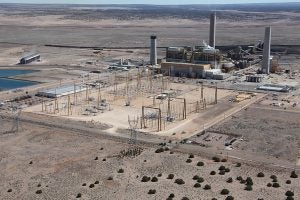The energy reality behind Cape Town’s water crisis – and why the U.S. should care
 In Cape Town, South Africa, the countdown is on for Day Zero when water taps in the city of 4 million people are expected to run dry.
In Cape Town, South Africa, the countdown is on for Day Zero when water taps in the city of 4 million people are expected to run dry.
Yet, while this water crisis has been making headlines worldwide, nobody’s talking about the connection between water and energy. In a rapidly changing climate, we should.
Cape Town may be the first major city staring down a water scarcity crisis, but it’s not alone. One-quarter of the world’s large cities, including at least two in the United States, are “water-stressed,” a 2014 study found.
As it turns out, many of them also happen to rely on the world’s thirstiest energy source: coal.
23,000 gallons of water a month to power a single home
In the symbiotic relationship known as the energy-water nexus, we use power to treat and distribute water, while water is used to process and deliver power. This is why our energy choices directly affect our water resources – and lack thereof.
Traditional power resources such as coal, natural gas and nuclear fission require on average 25 gallons of water to produce one kilowatt-hour of electricity. Coal plants top the list; they withdraw between 20 and 60 gallons of water per kilowatt-hour, depending on the plant’s cooling technology.
A typical American home uses about 900 kWh per month, which translates into nearly 23,000 gallons of water per household per month – just for electricity.
Which brings us back to Cape Town: 92 percent of South Africa’s power comes from coal. So while residents may be taking shorter showers and doing their best to conserve water, the country’s power plants are gulping it down.
Is Miami next?
Cape Town is in unchartered water territory and with climate change rapidly altering temperatures and weather patterns, U.S. cities probably aren’t far behind.
Climate predictions show an increasingly hot and dry America and the evidence is all too visible.
Only six months after Hurricane Harvey, Texas is back in drought. California could be living through more than a decade of drought, which has already upended the state’s agricultural industry.
And the water stress is spreading eastward. New England and the Southeast recently suffered unprecedented droughts – and Miami is now expected to be the first U.S. city to run dry.
This trend tells us that now’s the time to have a closer look at the energy-water nexus, and how to make the best use of what water we’ve got left.
These power sources use almost no water
The upside of all this is that we have a powerful water conservation tool with multiple co-benefits at our disposal: clean energy. Solar photovoltaics and wind power use virtually no water. Energy efficiency uses none.
To this day, 85 percent of U.S. electricity comes from our thirstiest energy resources, fossil fuel and nuclear power plants. Expanding the use of renewable energy and energy efficiency, while weaning ourselves off the thirstiest power sources, will lead to huge water savings at the right time.
This is our opportunity here and around the world as we plan for the reliability and resilience of our energy and water systems. It’s no longer possible to ignore the impact our energy sources has on critical water supplies, and vice versa.
We have already begun to turn toward a cleaner energy economy. The question now is whether we can ramp things up before the next big city goes dry.
This post originally appeared on our EDF Voices blog.
Photo source: SRP











2 Comments
Kate, modern fission plants do not “use” a drop of fresh water. They either use seawater (Diablo Canyon), put fresh water back where they got it (North Anna), or use recycled water unfit for consumption (Palo Verde).
One-fifth of the world’s population does not have access to safe drinking water, and a World Economic Forum report in January 2015 concluded shortage of fresh water “may be the main global threat in the next decade.” Though either desalination or purification of brackish water by reverse osmosis may be the only choice in some areas, both are energy-intensive. The largest reverse osmosis plant in the world, Al-Jubail 2 in Saudi Arabia, uses 2.7 GW of gas-fired electricity to supply Saudis with fresh water at a high price to climate, emitting 13 million tonnes of CO2 each year.
In contrast, zero-emission nuclear power plants are ideally suited to desalination. In off-peak times, their baseload electricity can be diverted to maintain water supply when unneeded for residential or industrial consumption. Yet Environmental Defense Fund steadfastly refuses to acknowledge the potential of safe nuclear energy for either clean electricity, or clean water. Why?
The IEA a while back had an article that stated that if only 40% of the water was recovered from the exhaust at a coal fired power plant, it would be self sustaining. If it recovered more it could be a water supplier to the local community.
The same goes with natural gas. In every 1 million Btu’s of combusted natural gas are 5 gallons of recoverable water, and this distilled water is very useable.
To get at this water the technology of Condensing Flue Gas Heat Recovery needs to be applied. It can be done at the power plants and at industrial facilities and at large commercial buildings.
http://www.SidelSystems.com
http://www.SidelGlobal.com